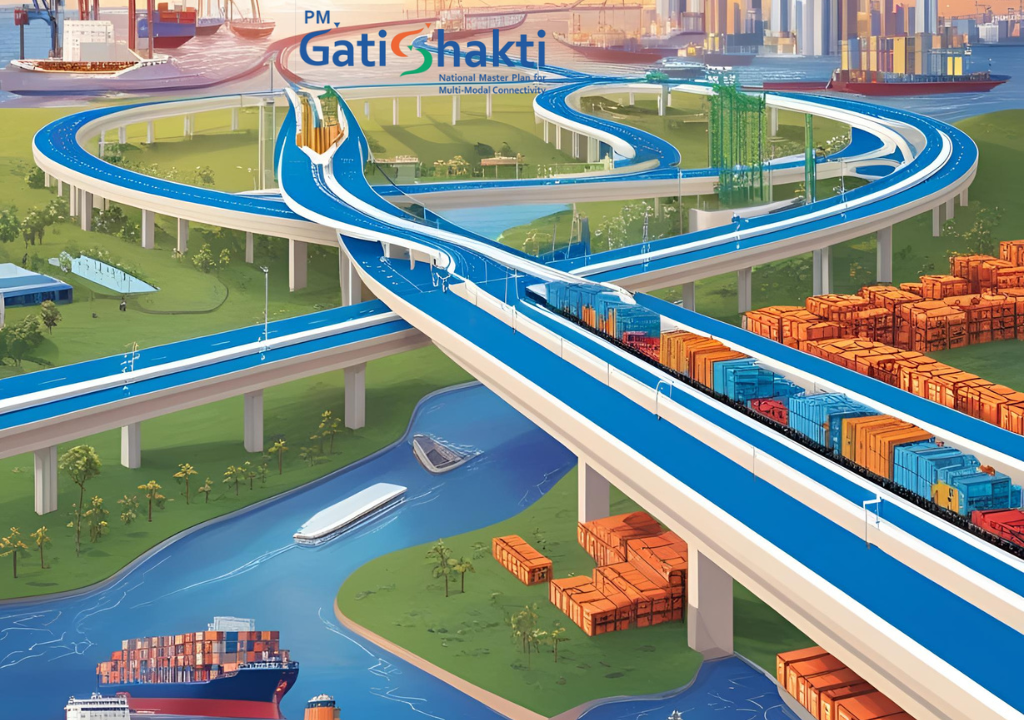Introduction
Introduced in October 2021, the PM Gati Shakti Plan is an ambitious push to modernize India’s infrastructure ecosystem through digital integration. It promises to dismantle bureaucratic silos, synchronize project planning, and elevate India’s logistics capabilities by creating a unified platform involving 16 key ministries.
But after over three years of groundwork, how much ground has actually been covered? This article critically examines the plan’s execution, measurable outcomes, and the persistent hurdles that still exist.
Understanding the PM Gati Shakti Plan
The PM Gati Shakti – National Master Plan for Multimodal Connectivity is a centralized technology-driven framework introduced by the Indian government. It aims to integrate infrastructure development efforts across transportation and communication sectors through a unified digital platform.
What Makes It Unique?
- Brings together 16 ministries including Railways, Road Transport, Aviation, Ports, and Telecom
- Uses GIS mapping for real-time project visibility
- Allows multi-ministerial collaboration on infrastructure projects
- Promotes efficiency and synchrony in public sector investments
The plan’s core philosophy is simple: better coordination leads to faster, cheaper, and more impactful infrastructure execution.
Key Goals and Strategic Intent of the Gati Shakti Plan
At its core, the PM Gati Shakti Plan is a bold effort to recalibrate India’s infrastructure framework into a unified, fast-moving, and outcome-driven ecosystem. The goal is to replace disjointed and delayed projects with synchronized, data-backed, and well-planned execution models.
Strategic Priorities of the Plan:
- Drastically lower logistics costs, bringing them down from 13–14% of GDP to below 8%—a benchmark closer to global standards.
- Accelerate project execution, significantly shortening the time it takes to move from approval to implementation.
- Create seamless connectivity between transport modes—road, rail, air, and sea—across industrial clusters and economic zones.
- Position India as a global logistics hub, boosting its manufacturing base and export capabilities.
- Foster collaboration between the public sector and private industry to maximize investment outcomes.
- Drive employment generation through the rapid roll-out of infrastructure-intensive capital projects.
This national master plan is aligned with the broader economic aspiration of turning India into a $5 trillion economy by enhancing core infrastructure and reducing logistical inefficiencies.
Mechanism: The Digital Engine Powering PM Gati Shakti
The PM Gati Shakti framework is built upon an advanced technology-enabled master planning system that integrates ministries, states, and public utilities under one digital roof. It transforms how infrastructure projects are conceived, tracked, and delivered.
Key Digital Components:
- Geospatial Information System (GIS) Dashboard: Offers interactive, map-based visualizations of national and state-level projects, helping planners identify connectivity gaps and overlaps.
- Data Integration Layer: Pools over 900 datasets sourced from various ministries and departments to enable real-time data-sharing and transparency.
- Planning Coordination Tools: Aligns upcoming infrastructure projects with ongoing developments to avoid duplication and improve synergy.
- Progress Monitoring Interface: Provides a centralized view of project statuses, expenditure, timelines, and roadblocks.
By shifting planning from isolated departmental silos to a collaborative, data-rich environment, the Gati Shakti platform empowers more intelligent and efficient decision-making across government bodies.
Milestones and Sectoral Progress Achieved
Though still in the scaling phase, the PM Gati Shakti Plan has already produced measurable improvements across key infrastructure verticals.
Highlights of Progress:
- More than 40 economic corridors have been strategically mapped to improve industrial logistics and cargo flow.
- Rail-linked freight terminals are being planned with multimodal integration in mind, enhancing efficiency.
- Clearance timelines for environmental and inter-agency approvals have been shortened through centralized review systems.
- Select manufacturing clusters have reported a noticeable drop in logistics costs.
- Linkages between ports and inland waterways are optimizing movement of goods from hinterlands to international gateways.
- Several state governments including Gujarat, Maharashtra, and Uttar Pradesh have introduced state-level dashboards modeled on the national platform.
In several use cases, the platform has led to smarter infrastructure placement, improved last-mile connectivity, and faster project mobilization.
Persistent Implementation Challenges:
Despite its promise, PM Gati Shakti full potential is being hampered by operational, institutional, and technical barriers on the ground.
- Fragmented data ecosystems still exist, with some departments failing to regularly update or integrate datasets into the shared platform.
- Varying state-level adoption: Not all states have adopted the platform uniformly, and differences in digital infrastructure slow onboarding.
- Lack of specialized manpower: There is a noticeable gap in technical know-how, especially at the district and departmental levels, to effectively use GIS and data planning tools.
- Limited private sector involvement: Private infrastructure players have yet to be integrated meaningfully into the dashboard for joint project planning or monitoring.
- Overlapping program goals: Confusion arises when multiple infrastructure initiatives like Bharatmala and Sagarmala intersect with Gati Shakti without clear demarcation.
- Infrastructure deficits in remote and underdeveloped areas continue to stall physical execution, despite centralized planning.
To overcome these barriers, focused capacity building, training, incentive structures, and stronger mandates are necessary to align all stakeholders with the plan’s strategic vision.
Conclusion: What Lies Ahead?
The PM Gati Shakti Plan has already begun to transform how India envisions, executes, and tracks infrastructure projects. It promises better connectivity, efficient investments, and real-time transparency across ministries—offering a glimpse into what future-ready governance can look like.
However, to unlock its full potential, India must:
- Expand state-level participation and training
- Encourage private sector adoption of the digital dashboard
- Strengthen integration with local governance bodies
- Create periodic audits to ensure data is updated and actionable
In its current state, the PM Gati Shakti Plan is partially effective, with immense potential for expansion. It is a robust foundation that, if nurtured, can redefine India’s infrastructure future—one project, one corridor, and one state at a time.le: PM Gati Shakti Plan: Transforming India’s Infrastructurer website’s CMS (like WordPress or Laravel)?

